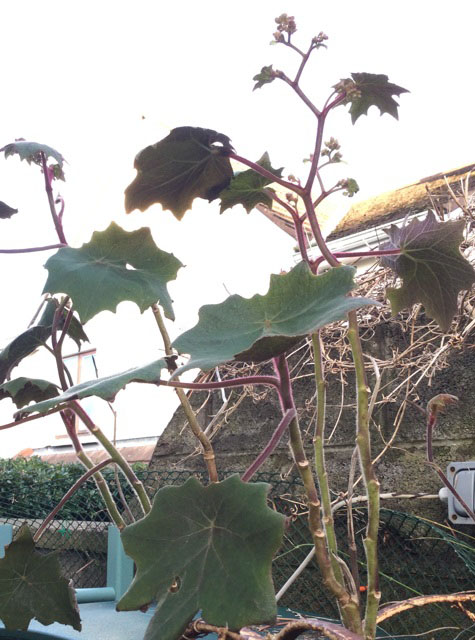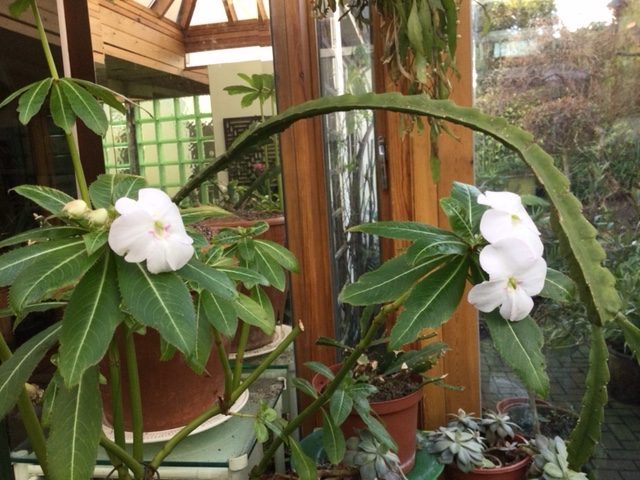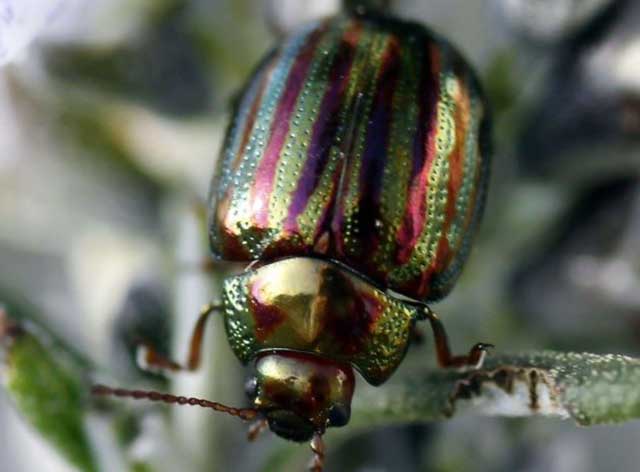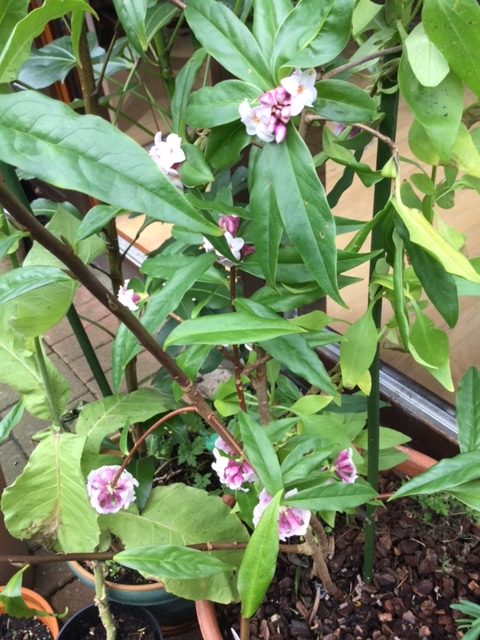February in our Gardens by Philippa Thomas
Each day, we are experiencing a few more precious minutes of daylight. After a few months of dormancy, towards the end of February, temperatures are slowly rising, light levels increasing and our dawn chorus is increasing in volume. All may seem quiet in the garden and sometimes, looking out our windows, we still see frigid stems and blank white skies, like almost as if they are frozen in time. However, rest assured, our Winter kissed gardens are slowly coming back into life again. Buds are opening on early spring blossom and our flowering bulbs are pushing their way through our soil. Admittedly, much of our present early magic is happening underground, far and away from our human eyes where early emerging pollinating insects need them most.

Senecio Christobalensis, Bought From Jimi Blake, Approx 8 Yrs Ago.
So Far, It Has Over Wintered. It Has Fabulous Dramatic Huge Velvety Leaves.
As we know in 2020, when the Corona Virus hit, a nation of accidental gardeners rediscovered their gardens. Gardening is good for our physical, mental and social wellbeing. In the words of Audrey Hepburn, ‘To plant a garden is to believe in tomorrow’. Gardening can help with depression and be tremendously beneficial for people suffering with bereavement, loneliness and illness. IT IS GREEN THERAPY. In these unsettled times, gardening may be the perfect antidote to some of our troubles and worries. There is always something requiring attention in the garden. It provides a general distraction to occupy our minds. It gives purpose, focus and an end result for our efforts. Scientific research has proven that getting dirty is actually good for us. Our soil contains the harmless bacterium Mycobacterium Vaccae which releases dopamine and serotonin, a natural anti-depressant in the brain and makes us happy. Likewise, sowing, growing and harvesting crops are incredibly therapeutic and rewarding. We should never underestimate the power of nature to calm and centre thoughts and to inspire hope for the future. The anticipation that there is something to look forward to, simply works wonders to lifting the spirits, gardening requires us to slow down, contemplate and appreciate the little details in life that can be easily missed if we’re racing around at full speed. It reminds us of our connection with nature and the wonderful cycle of life that is going on right under our very noses, (in my case, would love a shorter nose!) So, despite Covid, seeds will be sown, moved on, flowers will bloom, produce fruit and finally seed again and so our wonderful cycle of life continues. Is there not anything more re- assuring than this….
MAYBE, IDENTIFY YOUR SOIL TYPE. Remember, ‘right plant, right place’, and your plants will thrive. Soils can be identified in their general types by the way they feel and respond to handling. Pick up a handful and squeeze it together. Sand feels gritty and the grains do not stick together when squeezed. Loam feels velvety or flour-like when dry. Clay feels sticky but goes smooth when rubbed. Chalk will have large lumps and be hard to mould. Most importantly again, identify your soil type and work with it. Remember again, the golden rule, ‘right plant, right place’. Worm castings are an organic form of fertiliser produced from earthworms, also known as vermicast. Worm castings manure is essential earthworm waste, otherwise known as ‘worm pee’. Marvellous for improving soil aeration, drainage as well as increasing water retention in soil.
The benefit of seeding in February is if it goes well, the plants will mature earlier. Sowing in March and April is easier because of extra light and warmth. Ideally, seeds need to be placed into a sealed propagator to create a warm atmosphere which will not dry out. Rather than torture yourself with thread like, leggy seedlings right now by starting them too soon, perhaps divert your energies into taking suitable cuttings. Again, remember for later, one of the secrets of success with vegetables is to grow the best varieties.

Impatiens Sodenii, Today! (Jan 21st) It Has Been In Flower, Since Last Early Summer.
‘Oliver’s Touch-Me-Not’ . South Africa. I Grow As An Ornamental Plant In Glass Room
I don’t feed indoor plants till mid-February, as plants begin to notice slightly longer days. I then feed approx.. weekly and weakly. Occasionally, the odd plant gets a trip to the shower!
Wonder, are you into Polka Dots dominating your garden, ‘one-offs’…. you know lots of ones, one single plant of each type, ‘onesies’, instead of an impact, full group of drifts of several of the same variety. I much prefer the en masse effect….
ROSEMARY BEETLE

Rosemary beetle, (Chrysolina Americana,) has spread rapidly since first being found
breeding in central London in the late 1990s. It can eat the foliage and flowers
of some aromatic plants such as rosemary, lavender, sage and thyme.
Rosemary beetle is an insect that eats the foliage and flowers of various aromatic plants, such as rosemary, lavender, sage and thyme. Rosemary beetle has spread rapidly, since first being found breeding in central London in the late 1990s. Sure, they are beautiful. So, no harm to inspect your Mediterranean herbs for metallic green rosemary beetles if they start to look nibbled and tatty.
THE AGE-OLD PRACTICE, CALLED FORCING BRANCHES
Forcing spring branches into blossom indoors in a vase, is one of my favourite things to do. So maybe, bring your outside indoors, too! Create your own stunning display for the house and fill your house with fragrance. Willow, Pussy Willow, Forsythia, Spirea, Chimonanthus Praecox, Flowering Quince, Prunus Mume, Winter Honeysuckle are but a few stunners.
SOME MAGNIFICENT FLOWERING AND SCENTED SHRUBS WORTH PLANTING NOW
Daphne Jacqueline Postill, A Highly Fragrant Evergreen Medium-Sized Shrub. Presently, In Flower. Won This Beauty At Our 30 th Anniversary Celebration Raffle, In May 2018,In Beaufield Mews, Grown By Dr.Mary Toomey. So Much Thanks Mary, Love It.
- Daphne bhoula, Jacqueline Postill.
- Sarcococca confusa, a stunner.
- Chimonanthus Praecox, native to China, strongly scented pendant flowers.
- Hamamelis virginiana, spider like flowers on bare branches known as Witch Hazel
MIGHT DO, MAYBE FEBRUARY JOBS

Paphiopedilum Freckles, Just Opening Today, 4 spikes, Large Singular Slipper Orchid Flowers
- Transplant deciduous shrubs growing in the wrong place while they are still dormant.
- Best to keep off the grass if it is frozen or frosted, as the damage from your feet may show up as yellow patches.
- Citrus plants which have been over wintered indoors can be given a prune to encourage bushy growth.
- Wash parsley seeds in warm water the night before you want to plan to sow them and then, lay them out to dry on kitchen paper overnight. This washes off the germination inhibitor in the seed coat and will give you a harvest in a shorter time.
- Cacti have once again, become a popular choice of houseplant and require little attention. Winter, for most species is their dormant period, so they require little watering and no feeding yet. Be sure plants are receiving an adequate amount of light.
In February, Almost Everything Seems Possible. Maybe, whet your appetite by buying some seeds from some of our great suppliers:
a. Brown Envelope Seeds
b. Irish Seed Savers
c. Seedaholic
d. Quickcrop
e. Mr. Middleton.


